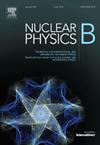Orthogonal splitting of the Riemann curvature tensor and its implications in modeling compact stellar structures
IF 2.5
3区 物理与天体物理
Q2 PHYSICS, PARTICLES & FIELDS
引用次数: 0
Abstract
Although the interpretation of complexity in extended theories of gravity is available in the literature, its illustration in theory is still ambiguous. The orthogonal decomposition of the Riemann tensor results in the emergence of complexity factor as recently proposed by Herrera [1]. We initiate the analysis by contemplating the interior spacetime as a static spherical anisotropic composition under the presence of charge. The modified field equations are derived along with the establishment of association between the curvature and conformal tensors that have significant relevance in evaluating complexity of the system. Furthermore, the generalized expressions for two different masses are calculated, and their link with conformal tensor is also analyzed. Moreover, we develop a particular relation between predetermined quantities and evaluate the complexity in terms of a certain scalar . Several interior solutions admitting vanishing complexity are also determined. Interestingly, compact objects having anisotropic matter configuration along with the energy density inhomogeneity possess maximum complexity. It is concluded that the spherical distribution of matter might not manifest complexity or admitting minimal value of this factor in the framework of theory due to the appearance of dark source terms.
黎曼曲率张量的正交分裂及其在致密恒星结构建模中的意义
虽然对引力扩展理论中复杂性的解释在文献中是可用的,但它在f(R,Lm,T)理论中的说明仍然是模棱两可的。黎曼张量的正交分解导致了Herrera[1]最近提出的复杂性因子的出现。我们首先将内部时空视为电荷存在下的静态球面各向异性组成。导出了修正的场方程,并建立了曲率与共形张量之间的关联,这对评估系统的复杂性具有重要意义。此外,还计算了两种不同质量的广义表达式,并分析了它们与保角张量的关系。此外,我们建立了预定量之间的特殊关系,并用一定的标量YTF来评估复杂性。还确定了几个允许复杂性消失的内部解决方案。有趣的是,具有各向异性物质结构和能量密度非均匀性的致密物体具有最大的复杂性。在f(R,Lm,T)理论框架下,由于暗源项的出现,物质的球形分布可能不表现出复杂性或承认该因子的最小值。
本文章由计算机程序翻译,如有差异,请以英文原文为准。
求助全文
约1分钟内获得全文
求助全文
来源期刊

Nuclear Physics B
物理-物理:粒子与场物理
CiteScore
5.50
自引率
7.10%
发文量
302
审稿时长
1 months
期刊介绍:
Nuclear Physics B focuses on the domain of high energy physics, quantum field theory, statistical systems, and mathematical physics, and includes four main sections: high energy physics - phenomenology, high energy physics - theory, high energy physics - experiment, and quantum field theory, statistical systems, and mathematical physics. The emphasis is on original research papers (Frontiers Articles or Full Length Articles), but Review Articles are also welcome.
 求助内容:
求助内容: 应助结果提醒方式:
应助结果提醒方式:


